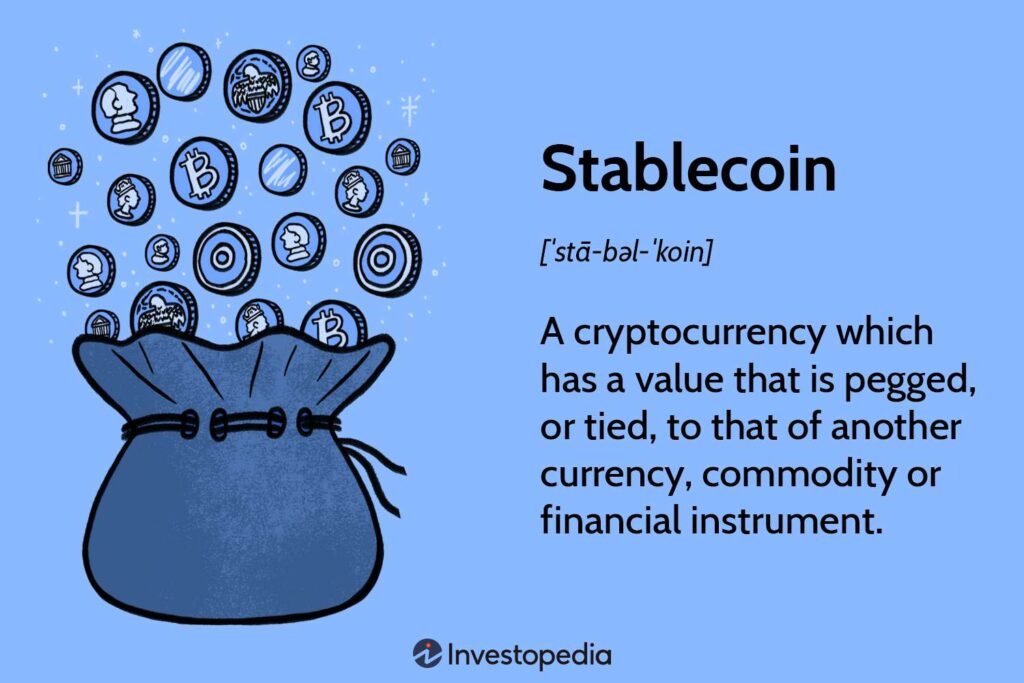:max_bytes(150000):strip_icc():format(jpeg)/terms_s_stablecoin_FINAL-89e1671b1f24486b84b74cebe6836573.jpg)
Stablecoins are reshaping how we save, spend, and move money at a time when the U.S. dollar itself faces unprecedented challenges. In 2025, the dollar’s share of global reserves hit a 30-year low of 57.7%, as aggressive U.S. trade policies and tariffs, reaching levels not seen in more than a century, have prompted central banks to diversify into alternatives like gold.
Yet paradoxically, this turmoil may be boosting demand for dollar-backed stablecoins. As of mid-2025, dollar-denominated stablecoins account for over 99% of the global stablecoin market, now valued at more than $230 billion. U.S. policymakers have also promoted dollar-backed stablecoins as a means to maintain American financial dominance in a digital future. But could the spread of stablecoins eventually threaten the dollar’s dominance in global trade?
Key Takeaways
- Dollar-backed stablecoins currently reinforce U.S. dollar dominance in global payments, but their rapid growth raises new risks for financial stability and monetary sovereignty.
- Regulatory gaps, reserve transparency, and the risk of “runs” on stablecoins are major concerns for policymakers and consumers.
Could Stablecoins Undermine or Reinforce Dollar Dominance?
The potential impact of stablecoins on the dollar’s global role is hotly debated. Eneko Knörr, CEO of Stabolut, told Investopedia, “For the U.S., dollar stablecoins strengthen dollar dominance.” Stablecoins may boost demand for U.S. Treasurys and cement the dollar’s position in cross-border payments and reserves by making dollars simpler to use abroad.
However, some experts warn of longer-term risks. Brian Rudick, chief strategy officer at UPEXI, noted, “Bitcoin’s broad acceptance, especially by sovereigns, may erode the dollar’s standing as the global reserve currency and make it harder for the U.S. to run deficits.” If non-dollar stablecoins or alternative digital assets gain traction, they could fragment global liquidity and challenge U.S. monetary power.
Dean Baker, co-director of the Center for Economic and Policy Research, told Investopedia that the direct impact of stablecoins on dollar dominance is likely to be “trivial.” He argues that central bank digital currencies could offer the same advantages as stablecoins, without the added risks of private issuers. Baker cautions that stablecoins add complexity and may drain resources from more productive uses.
Regulatory Concerns and Financial Stability Risks
Stablecoins present unique regulatory challenges. While U.S. lawmakers are advancing new frameworks to oversee stablecoin issuers, questions remain about the quality of reserves, transparency, and oversight. If reserves are mishandled or illiquid, a “run,” when users rush to redeem stablecoins for dollars, may endanger crypto marketplaces and the financial system.
Baker said that simply requiring 100% reserves is not enough to make stablecoins live up to their name. “There are definitional problems, what counts as a reserve? Issuers will always pressure regulators to be lax, since reducing reserve requirements is how they make money,” he said. Fragmented oversight, especially at the state level, could invite regulatory arbitrage (a practice where firms look for loopholes within and between regulatory systems) and instability.
Policymakers are also concerned about the use of stablecoins in sanctions evasion, fraud, and illicit finance. Their potential to crowd out bank deposits and disrupt credit markets is also a major concern.
What Stablecoins Mean for Consumers
Stablecoins promise quicker, cheaper payments and more financial access, but also present new risks that might affect your wallet.
Potential Benefits
- Faster, cheaper payments: Stablecoins can help consumers avoid banking costs and allow near-instant, low-cost international transfers, particularly in nations with weak financial institutions.
- Financial inclusion: Stablecoins might provide digital currency and global trading access to the unbanked and less financially stable.
Risks and Considerations
- Fraud and value loss: Stablecoin payments are rapid and irrevocable, making them vulnerable to fraud and mistakes.
- Limited consumer protections: Stablecoins may not be insured or provide recourse for fraud or bankruptcy, unlike bank deposits.
- Regulatory uncertainty: Changes in laws may affect the usage, taxation, or prohibition of stablecoins in certain areas.
The Bottom Line
Dollar-backed stablecoins could help reinforce the U.S. dollar’s dominance in global finance, but their rapid growth brings new risks to financial stability, consumer protection, and monetary sovereignty.
For everyday users, stablecoins offer speed and access, but also expose them to new forms of uncertainty. “The big risk is that people will get to feel comfortable holding wealth in stablecoins under the assumption they are secure and well-regulated,” Baker warned. “They may then find that their specific stablecoin was not stable and they are suddenly holding a near-worthless asset.”

